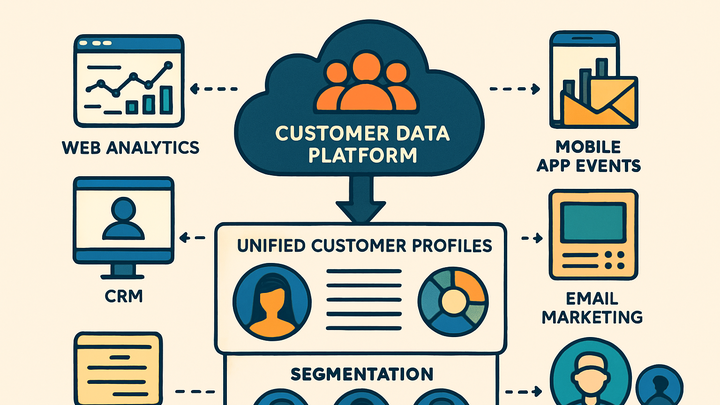Published on 2025-06-22T07:21:28Z
What is a Customer Data Platform (CDP)?
A Customer Data Platform (CDP) is a type of software that centralizes and unifies customer data from multiple sources into a single, persistent database. CDPs collect first-party data from web analytics, mobile apps, CRM systems, email platforms, and offline channels. They resolve identities to create unified profiles, ensuring that every interaction is connected to the correct customer. The unified data can then be used for analysis, audience segmentation, and activation across marketing and advertising tools. By providing a real-time, comprehensive view of each customer, CDPs enable more personalized and compliant marketing strategies. Examples of CDP vendors include Segment, Tealium, and mParticle, while analytics platforms like PlainSignal and Google Analytics 4 often serve as data sources in a CDP architecture.
Customer data platform (cdp)
CDP: a centralized platform that collects, unifies, and manages customer data from multiple sources to build a single customer view for activation.
How a CDP Works
A Customer Data Platform works by ingesting data from various sources, resolving identities, unifying profiles, and making that data available for analysis and activation in marketing campaigns.
-
Data collection
Captures first-party data from websites, mobile apps, CRM systems, email platforms, and offline sources in both batch and real-time modes.
-
Identity resolution
Combines multiple identifiers—such as email addresses, cookies, device IDs, and CRM records—into a single customer profile.
-
Deterministic matching
Uses exact matches on known identifiers (e.g., email, phone number) for high-confidence linking.
-
Probabilistic matching
Applies statistical methods and machine learning to infer links between records when exact matches aren’t available.
-
-
Data unification & storage
Stores the cleansed and unified customer profiles in a centralized, scalable repository with governance and privacy controls.
-
Segmentation & activation
Enables creation of dynamic customer segments for personalized marketing, and activates those segments across advertising and messaging channels.
-
Email campaign sync
Exports target segments to email service providers like Mailchimp or SendGrid.
-
Ad platform integration
Syncs audiences to platforms such as Google Ads and Facebook Ads for retargeting.
-
Key Benefits of a CDP
Implementing a CDP delivers multiple benefits that can transform marketing, sales, and customer experience by providing a unified, real-time view of each customer.
-
Unified customer view
Brings all customer interactions and attributes into a single profile to power deeper insights and personalization.
-
Improved personalization
Enables highly targeted messaging based on behavior, preferences, and context at an individual level.
-
Cross-channel orchestration
Coordinates campaigns across email, web, mobile, and advertising platforms from one central system.
-
Data privacy & compliance
Offers built-in consent management and data governance features to help comply with GDPR, CCPA, and other regulations.
Examples: PlainSignal & GA4 in a CDP Strategy
Analytics tools such as PlainSignal (cookie-free) and Google Analytics 4 (GA4) can be sources of customer data that feed into a CDP for broader unification and activation.
-
PlainSignal integration
PlainSignal is a cookie-free, privacy-focused analytics platform that tracks user behavior. You can add the following snippet to your site to collect data:
<link rel="preconnect" href="//eu.plainsignal.com/" crossorigin /> <script defer data-do="yourwebsitedomain.com" data-id="0GQV1xmtzQQ" data-api="//eu.plainsignal.com" src="//cdn.plainsignal.com/plainsignal-min.js"></script>This data can then be sent to your CDP via API for unified customer profiling.
-
Google analytics 4 (GA4) integration
GA4 collects first-party data and offers a native integration to export data to BigQuery. You can then connect your BigQuery export to a CDP for advanced identity stitching and activation across channels.
